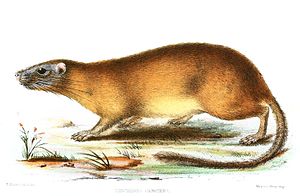Tree rat rats
| Tree rat rats | ||||||||||||
|---|---|---|---|---|---|---|---|---|---|---|---|---|

Gray-headed tree rat ( Diplomys caniceps ), drawing by R. Mintern |
||||||||||||
| Systematics | ||||||||||||
|
||||||||||||
| Scientific name | ||||||||||||
| Diplomys | ||||||||||||
| Thomas , 1916 |
Tree sting rats ( Diplomys ) are a genus of the family sting rats (Echimyidae) with two to three species.
features
The fur of these rodents is coarse, but there are no real spines. The color varies on the upper side between reddish brown, reddish and orange with darker areas due to interspersed black hair. On the underside, the fur is light brown to pink. The brown tail is covered only with thin hair. Sometimes an inconspicuous black or white tassel appears.
Tree spiny rats reach a head-trunk length of 20 to 48 cm and a tail length of 18 to 28 cm. They weigh 360 to 430 g. Pregnant females of the Panama tree prickly rat can even reach a weight of 490 g.
Types and distribution
Mammal Species of the World (2005) lists three species in the genus:
- The gray-headed tree rat ( Diplomys caniceps ) is only known from a small area in the mountains of Colombia .
- The Panama tree spiny rat ( Diplomys labilis ) occurs from central Panama to northern Ecuador .
- The redhead tree rat ( Diplomys rufodorsalis ) is endemic to northeast Colombia. During a revision of the tree sting rats carried out in 2005, this species was placed in its own genus, Santamartamys .
Way of life
Tree rat rats can be found in the hill country and in the mountains, where they inhabit moist forests and bushes. They are nocturnal and skillfully climb trees and other plants. They can jump distances of up to one meter between branches. Specimens kept in captivity could be fed on fruits, grains and almonds . Pregnant females with one or rarely two embryos were found at different months.
Web links
Individual evidence
- ^ A b c Ronald M. Nowak: Walker's Mammals of the World. Volume 2. 6th edition. 1999, p. 1695 ff. ISBN 0-8018-5789-9
- ↑ Don E. Wilson , DeeAnn M. Reeder (Ed.): Mammal Species of the World . A taxonomic and geographic Reference . 3. Edition. 2 volumes. Johns Hopkins University Press, Baltimore MD 2005, ISBN 0-8018-8221-4 (English, Diplomys ).
- ^ Louise H. Emmons: A Revision of the Genera of Arboreal Echimyidae (Rodentia: Echimyidae, Echimyinae), With Descriptions of Two New Genera. In: Eileen A. Lacey, Philip Myers (Eds.): Mammalian Diversification. From Chromosomes to Phylogeography. (A Celebration of the Career of James L. Patton) (= University of California Publications in Zoology. Vol. 133). University of California Press, Berkeley CA et al. 2005, ISBN 0-520-09853-6 , i-vii and pp. 1–383, here pp. 247-310.